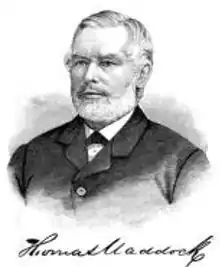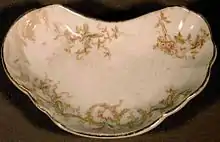Thomas Maddock
Thomas Maddock (April 1, 1818 – June 16, 1899) was an inventor and potter. He invented devices that made plumbing fixtures more practical and started the American indoor toilet industry. Maddock was decorator for a set of White House tableware dishes for President Franklin Pierce.

Early life
Maddock was born in the Staffordshire area of England on April 1, 1818. He was the third child of nine in the family. William, the first child, died at an early age. His other siblings were: three brothers, John, William B., Henry; his four younger sisters were Sarah, Betsy, Mary and Jane.[1]
Maddock's father was Thomas Maddock, Sr. His mother was Mary Maddock (née Crompton). His father was a decorator of fine china at the Davenport Pottery manufacturing firm as was his uncle, John Maddock Jr. Maddock worked at Davenport Pottery as a decorator while a teenager, under the supervision of his father and uncle.[1]
Mid life

Maddock married Miss Honor Bossoms in 1844 at the age of 26. English pottery business opportunities were not available at the time so they decided to emigrate to America in 1847.[2] Maddock started a business decorating dinnerware in New York with William Leigh, a friend that also emigrated to America contemporaneously. Maddock with Leigh started the first American china decorating shop. The concept of firing of decorated dinnerware was then unknown in America. Maddock obtained prominence by the decoration of dinner services for President Pierce at the White House in 1853.[3] The St. Nicholas Hotel in New York City opened in the same year and the Maddock & Leigh firm decorated dinnerware for them.[4]
Maddock joined the thirteenth regiment of the national guard of New York during the American Civil War. After the war he became a sales agent in 1872 for 'Millington & Asthury,' manufacturers of porous tableware in Trenton, New Jersey. He became closely associated with their business affairs and on April 4, 1873, a new partnership was formed called 'Millington, Astbury & Maddock.'[4] Millington left the firm to start his own pottery business and the 3-man partnership of 'Millington, Astbury & Maddock' became then the two-man partnership firm of 'Astbury & Maddock'.[4] Maddock and his sons eventually took over this firm and renamed it Thomas Maddock & Sons.[5]
Sanitary ware

Maddock believed that sanitary ware (non-porous china ware), then only imported in small quantities from England,[6] could be made more favorably in America.[7] He started experimenting with pottery formulas and firing techniques to develop this state-of-the-art technology. Initially his failure rate on batches of 50 pieces was typically 90%.[8] Maddock eventually perfected the techniques to make vitrified glass surface pottery, sanitary ware (also called bathroom/toilet ware or water closet).[8]
Maddock then in the spring of 1873 set out to sell his sanitary pottery line. His salesman's display consisted of a sheet of dark gray muslin about the size of a bed sheet. When he went to call on a china dealer he assembled his salesman's samples in the center of the muslin sheet that laid on the floor. The samples were a 14-inch P. O. basin, a 14-inch C. O. basin, a 14-inch R. P. basin and a French closet. These items weighed about fifty pounds. He tied the four corners of the sheet together making a handle and carried the samples over his shoulder. With his improvised salesman's display he demonstrated to many dealers (a/k/a jobbers). His prospect area was New York City and Brooklyn. For over six months he visited dealers with no sales. It wasn't until the end of the year that he obtained a small order from Miller and Coates of New York City. Waeffelaer and Duysters followed with an order. Other jobbers then placed orders with Maddock.[9]
In 1876 'Astbury & Maddock' exhibited their white general use tableware and sanitary ware (a/k/a/ modern toilet) at the first World's Fair held in the United States.[10] They won a medal for their unusual pottery.[11] Maddock’s firm in Trenton lead the way in the new industry of American toilets.[2][12] Trenton soon captured the majority of the American market for sanitary ware (indoor toilets), producing over eighty five percent of the national market.[5][7][10]
Maddock's toilet device invention

Maddock improved the old fashion early nineteenth century plumbing method of connecting lead pipe to a toilet by inventing a brass coupling replacement. His 1880 invention allowed the plumbing to be directly connected to the earthenware china toilet. The old school method involved a porcelain horn extending from the flushing rim connecting to the sewer lead pipe and the whole contraption held together by strips of muslin and putty.[13] His invention made a direct solid connection and was the state-of-the-art technology that went into the twentieth century.[14]
Family
Maddock married Honora Bossom first. The children they had were William and John. Maddock married Isabella Smith Middleton second. The children they had were Harold, John, Charles, Archibald, Harry, Jannet, and Isabella.[15]
Retirement and death
Maddock retired when he was 65 years old in 1883. He died in New Jersey on June 16, 1899. There is a Will recorded in the New York Surrogate's Court records "Vol 441–444, 1890–1891" in New York County in the state of New York (USA).[16]
See also
References
- Paul 2013, p. 9.
-
Gray, Ronald E. (2004). "T. Maddock's sons Company". Stein Collectors International. Retrieved November 29, 2015.
Soon other jobbers, like Waeffelaer and Duysters, placed orders with Thomas, and the sanitary pottery industry in America was born.
- Godden 1964, p. 406.
- Paul 2013, p. 10.
- "The Maddocks of Trenton: Kings of Industry". The Trenton City Museum at Ellarslie in Cadwalader Park. Apr 23, 2014. Retrieved December 2, 2015.
- US Government 1901, p. 155.
- Sines, John H. "A History of Trenton 1679–1929". The Old Mill Hill Society. Rootsweb. Retrieved November 29, 2015.
- Paul 2013, p. 11.
- Maddock's 1910, pp. 24–25.
- Bar, Edwin (2015). "MARKS of AMERICAN POTTERS". TrentonHistory.org. Trenton Historical Society. Retrieved November 30, 2015.
- Stradling 1976, pp. 146–158.
- Manufacturers' Association Bulletin. Manufacturers' Association of New Jersey. 1922. p. 6.
Of the original partners John Astbury and Richard Millington formed in 1873 a partnership with Thomas Maddock, and with this co-partnership was born the sanitary pottery business in this country.
- Thomas Maddock's Sons Company (1910). "Pottery. A history of the pottery industry and its evolution as applied to sanitation, with unique specimens and facsimile marks from ancient to modern foreign and American wares". Internet Archive. Smithsonian Libraries.
An incidental item of Mr. Maddock's ingenious labors with sanitary pottery was his invention of the method of fastening a brass coupling to earthenware. Prior to his patent of June 29, 1880, all closets were connected with the lead pipe of the plumbing by means of a porcelain horn, extending from the flushing rim of the earthenware. The lead pipe was thrust inside the horn, the crevice filled with putty and the whole held firmly together by binding with strips of muslin. Mr. Maddock's invention made it possible to couple the plumbing directly to the earthenware by means of a brass coupling, and that method is now almost universally followed.
- Maddock's 1910, p. 26.
- Paul 2013, p. 9-10.
- Sanitary Pottery in the United States, published by Thomas Maddock’s Son’s Company, Trenton, NJ, 1903. Also condensed in Bulletin 16 of the American Ceramic Society, 1937, pages 384–86.
Sources
- Godden, Geoffrey A. (1964). Encyclopaedia of British pottery and porcelain marks. Crown, Bonanza Books. ISBN 9780517097298.
- Maddock's, Thomas, Sons Co (1910). Pottery: A History of the Pottery Industry ... Spencer.
Feeling a natural, and, it is believed, not unworthy pride in perpetuating the name of the first manufacturer of sanitary pottery in the United States, the present Company offers the story of his work to those who now share the benefits which have sprung out of it.
- Paul, Larry R (2013). From earth to art : the history of the Lamberton Works (PDF). Larry R Paul.
Thomas invented a method of fastening a brass coupling to the china. This made it possible to couple the metal pipe directly to the toilet. Thomas received a patent for the invention on June 29, 1880, and it was universally adopted within a short time.
- Stradling, J.G. (1976), The Magazine Antiques (July), American Ceramics and the Philadelphia Centennial
- US Government (1901). Reports of United States Industrial Commission.